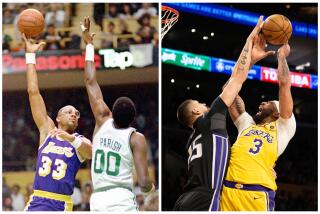Not Winning? You May Need a Hard Look at the Vision Thing
- Share via
“Keep your eye on the ball.”
“You’ve got to focus.”
“Concentrate.”
For most athletes, these coaching tips are a familiar part of regular practice dialogue. But until recently, experts say, many coaches were not thinking about the importance of a player’s vision and how it could be affecting performance.
Optometrists say that from the Little League field to the major league ballpark, coaches and athletes are becoming more aware of the importance of vision correction and eye protection.
Says William Harrison, a Laguna Beach optometrist and sports vision specialist, recognizing and correcting vision problems is very important in sports because reaction speed is the key to avoiding serious injury.
“When children and adults don’t see well, they see things, but they don’t see things fast enough,” Harrison says. “They’re not visually aware of potential hazards.”
Squinting, blinking, closing one eye to see, rubbing the eyes, tilting the head, complaints of headaches, blurred vision and overall diminished performance are all indications of impaired vision, says A.I. Garner, O.D., executive director of the International Academy of Sports Vision in Harrisburg, Pa.
Garner said a study conducted from 1970 to 1975 found that about 30% of 30,000 athletes, from youths to professionals, fail a simple vision test.
Because some children embarrassed about vision problems tend to conceal them, the sports vision academy developed a new program to identify youngsters with vision problems and to direct those who need help to eye-care professionals.
“Most of these kids either don’t know they have a problem and have never had an eye exam or don’t wear their eyeglasses because they’re afraid of breaking them,” Garner said.
Through the program, “Operation Youth Sports,” coaches are offered a simple screening test to identify players whose performance may be hindered by visual problems, Garner said.
“It’s a problem that often goes undetected during an age where the eyes change rapidly,” Garner said. He added that school vision screenings catch some children’s impairment but that parents and coaches should not rule out a vision problem just because a child has been tested at school.
Harrison, who has corrected vision problems of players on the Pittsburgh Pirates, Atlanta Braves, Chicago Cubs and Los Angeles Dodgers, said there are several options for children and adults who need their vision corrected during sports.
For instance, eyeglasses made of polycarbonate are almost unbreakable, he said, and “now kids can wear safe contact lenses at 8, 10 and 12 years old.”
Charlie Harris, 28, of Newport Beach, a member of the U.S. Olympic water polo team, started wearing contact lenses in the pool in 1990. His nearsightedness was affecting his game.
“I could see my teammates when they were close by, but (from a distance, I) couldn’t tell who was who,” Harris said. “I was kind of improvising because I couldn’t see very well.”
Harris said it is difficult for water polo players to see with goggles during play, so contact lenses were the best solution.
“I’m shooting a lot better now,” he said.
For those with perfect vision, there is still the matter of protection.
Participation in outdoor sports such as surfing and water polo can lead to ocular damage if the eyes are inadequately shielded from ultraviolet rays, Harrison warns. (Tanning booths can pose a similar risk.) Salt water can be harmful to the sensitive eye tissues too, and the combination of ultraviolet rays and drying salt water can contribute to cataracts later on, Harrison says.
And there is the matter of body contact. “Professional basketball,” for example, “is very aggressive, with those big fingers and hands,” Harrison points out.
To ensure proper protection, look for sunglasses marked “UV 400.” That means they provide 100% ultraviolet absorption up to 400 nanometers, says Rich Smith, sales representative for Oakley Inc., a sunglass manufacturer in Irvine. Smith explained that a nanometer is a measure of light.
“UV 400 is the minimum you would really want to go for,” he said. “Anything below 400 and you start damaging your eye.”
In addition to wearing the proper sunglasses, Harrison recommends that eyes that will be exposed to bright sunlight and salt water be lubricated with “artificial tears.”
More to Read
Go beyond the scoreboard
Get the latest on L.A.'s teams in the daily Sports Report newsletter.
You may occasionally receive promotional content from the Los Angeles Times.










